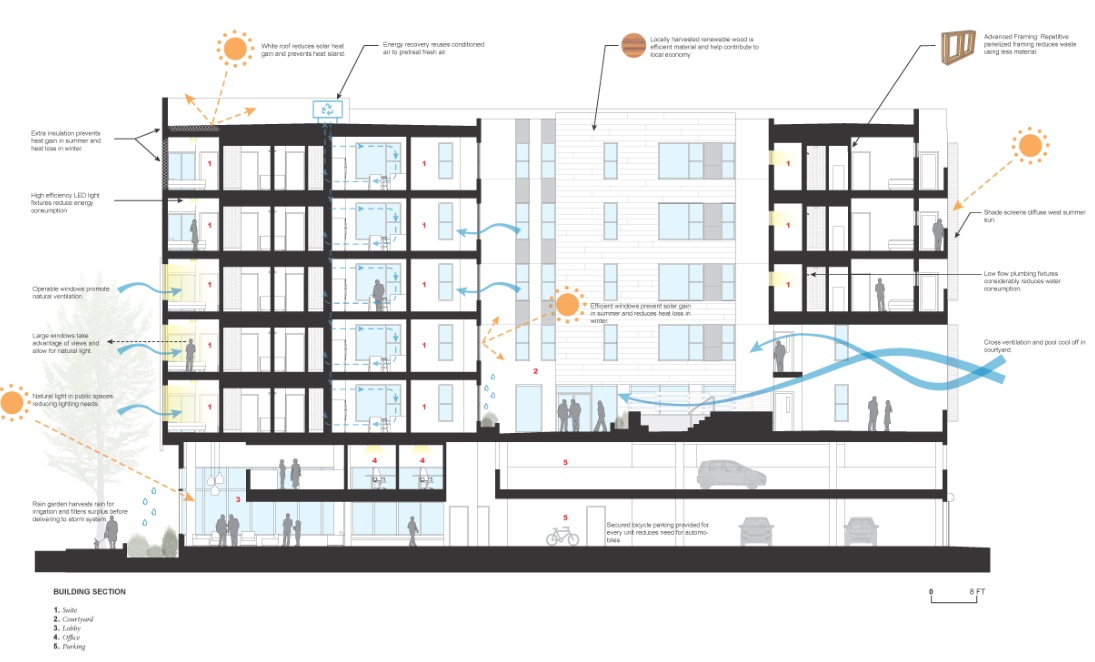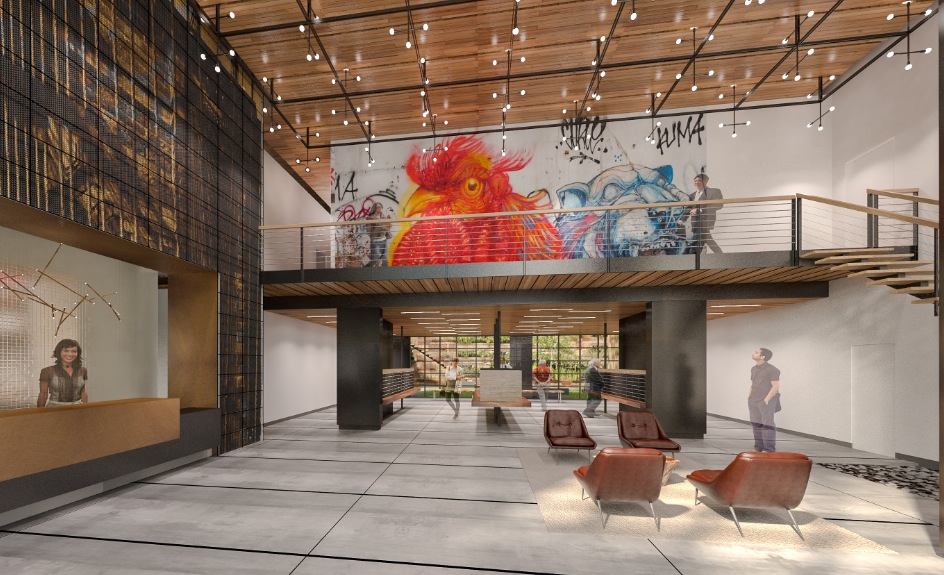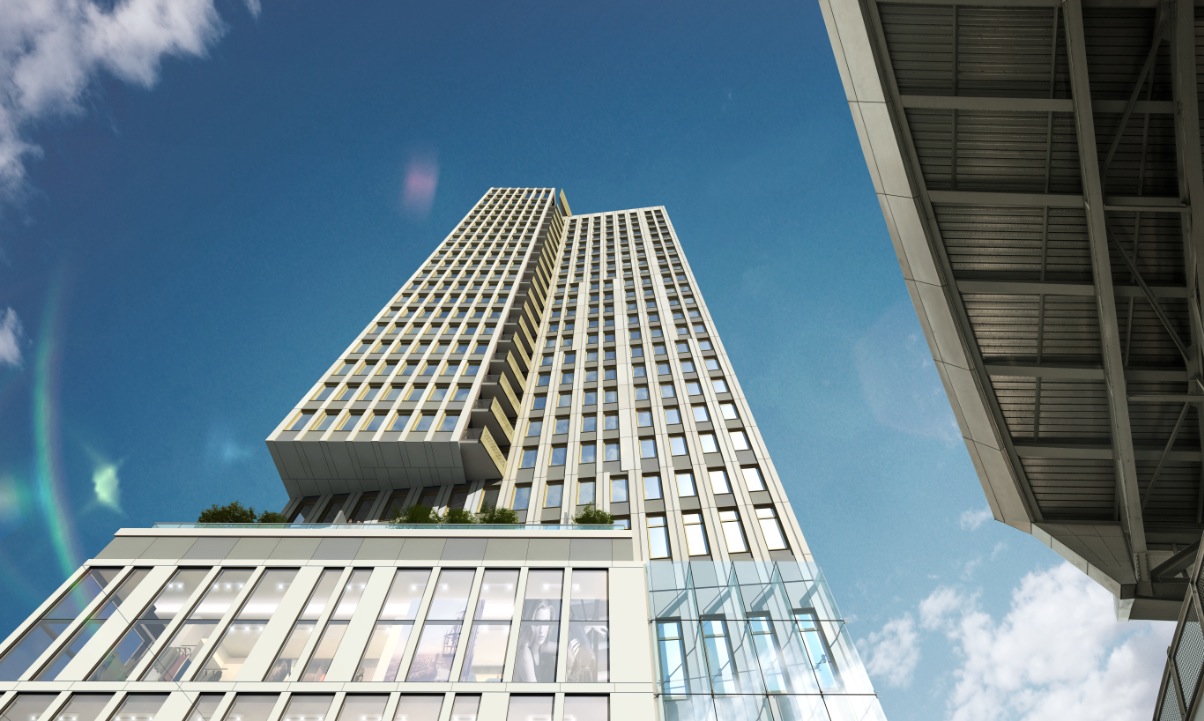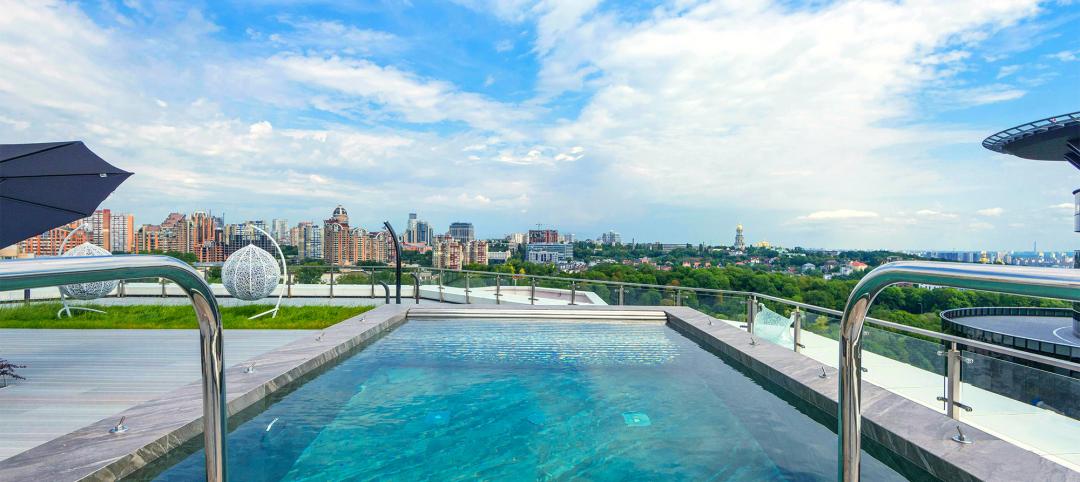As demand for multifamily apartments, condos, and townhouses has expanded, so has demand from developers, owners, and tenants for energy-efficient and sustainable buildings. This is particularly true for projects in the urban core coveted by supposedly environmentally conscious Millennials, and in locales where energy and water regulations are stiffening.
In New York, Mayor Bill de Blasio’s “80 by 50” Committee has set a goal of reducing the city’s greenhouse gas emissions by 80% below 2005 levels by 2050. “They’re talking about a lot of changes to codes,” says committee member Ilana Judah, International Associate AIA, OAQ, LEED AP BD+C, CPHD, Principal and Director of Sustainability with FXFowle.
“Cities are heightening their standards for efficient energy usage and sustainability, as they look to reduce resource consumption,” says Kelly Farrell, AIA, LEED AP BD+C, Vice President, RTKL Associates, Los Angeles (whose brand is now merged with Callison’s). This push at the municipal level has resulted in a noticeable increase in demand for smart design solutions. “For us, the real opportunity is in finding a way to meet these new regulations and ensure that the result translates into added value for our clients,” she says.
Kevin Smith, Senior Project Manager at Balfour Beatty Construction, says ASHRAE now requires more stringent energy modeling for building skin insulation. “The R-values of insulation within the interior wall cavity have been increased,” says Smith. He says EIFS systems installed on extruded polystyrene make for a well-insulated skin. In the 1980s, improperly installed EIFS caused mold problems that led to lawsuits. “Now we know to keep EIFS 48 inches off the ground and utilize an elastomeric finish for the final color coating,” says Smith.
Multifamily developers are using sustainability as a selling point, especially in environmentally conscious markets like California and the Pacific Northwest, says Joe Herzog, AIA, Principal with Shepley Bulfinch in its Phoenix office.
For Uncommon, an 120-unit apartment complex five minutes’ walk from the University of Oregon in Eugene, the firm worked with the client (CA Student Living) and GC (Essex General Construction) to pursue LEED Gold certification, even though it was not required. “We’re responding to changes in the urban housing marketing for college students and graduates,” said JJ Smith, CA Student Living’s COO. “They’re looking for a smaller environmental footprint and well-designed spaces close to life on campus and the city.”
 Uncommon, a 120-unit apartment building near the University of Oregon, Eugene, features energy recovery ventilation, which exchanges energy in already conditioned air to pre-treat incoming outdoor air. The Building Team: Shepley Bulfinch (architect), Innovative Air (mechanical contractor), and Essex General Construction (GC). Schematic courtesy Shepley Buifinch.
Uncommon, a 120-unit apartment building near the University of Oregon, Eugene, features energy recovery ventilation, which exchanges energy in already conditioned air to pre-treat incoming outdoor air. The Building Team: Shepley Bulfinch (architect), Innovative Air (mechanical contractor), and Essex General Construction (GC). Schematic courtesy Shepley Buifinch.
A number of “green prerogatives” (Herzog’s term) are having a beneficial impact on multifamily design and construction:
1. The multifamily market remains positive about the value of third-party sustainability certification. “The more LEED projects, the merrier,” says RTKL’s Farrell. But don’t get caught up in chasing LEED points. “If you truly commit to exploring the available options, the scorecard becomes a reflection of the project goals, rather than the other way around,” she says.
FXFowle’s Judah says that 80% of her firm’s high-rise projects in New York and Washington, D.C., are pursuing certification from either LEED or New York’s Enterprise Green Communities. In New York, any such projects built on city-owned land may have additional performance stipulations attached to them.
2. Heating and cooling systems are becoming much more sophisticated. Shepley Bulfinch’s 120-unit Uncommon project incorporates an energy-recovery system, which recycles preconditioned air and mixes it with fresh air. It is expected to save $40,000 a year in energy costs.
Multifamily properties are also providing tenants with the means to monitor their energy (and water) consumption. An RTKL project, The View—which is part of the 2.25-million-sf Liberty Center South mixed-use development in Arlington, Va.—installed Nest thermostats in every unit to meet this need. Some apartment projects even pay end-of-year rebates to tenants with low energy usage.
3. Resiliency comes to the fore in multifamily. After Hurricane Sandy, says Judah, developers suddenly became more interested in buildings that could create their own energy on site, via cogeneration systems that generally use microturbines or reciprocating engines.
4. Water use is a hot topic in almost every community, says Herzog. Rain gardens are collecting water for reuse. Low-flow plumbing fittings are routine. Balfour Beatty’s Smith says he is seeing greater use of graywater recycling for irrigation and sanitary systems.
5. Technology is forging a path in multifamily projects. LED lighting is steadily gaining acceptance in multifamily projects, says Smith. There has been a real evolution in building materials, especially in nontoxic paints, carpeting, and furniture fabric. “Health and wellness are big drivers,” says FXFowle’s Judah. Herzog notes that so-called “smart” plastic membranes can now sense interior humidity and allow an apartment or condo building to breathe and dry out.
6. Reducing heat island effect is growing in importance. Balfour Beatty Construction is working on Alta Midtown, a 369-unit development in Atlanta, which is being built on top of what was once an asphalt parking lot. Balfour Beatty recycled the asphalt and used it as backfill, then built a seven-story parking structure to reduce the overall heat-island effect. The surface will be a combination of white concrete, white TPO roofing membrane, green lawn space, and eco-friendly pavers and walking paths.
7. Passive House principles are attracting attention in multifamily projects. Judah, a Certified Passive House Designer, says her firm recently received a six-month grant to study the feasibility of passive design in taller buildings. Judah says there’s a “big movement” in New York toward passive design, which relies heavily on having a low window-to-wall ratio. She says her firm is encouraging multifamily developers to get off what she calls “their addiction” to predominantly glass façades.
FXFowle is pursuing LEED Silver for a market-rate rental building in Long Island City, N.Y., where the window-to-wall ratio will be less than 40%. Ditto for a 600-unit affordable/market-rate project in Jamaica, Queens, which will include cogeneration capability, green roof terraces, and possibly rainwater recapture.
 The lobby of the Purves Street Residential Development on Long Island City, N.Y. The 35-story, 266,000-sf building accommodates 270 units, and includes a communal living room, outdoor movie screening area, roof deck with a pool, and sky lounge. FXFOWLE is the architect; Brause Realty and Gotham Organization are the developers. Rendering: FXFOWLE
The lobby of the Purves Street Residential Development on Long Island City, N.Y. The 35-story, 266,000-sf building accommodates 270 units, and includes a communal living room, outdoor movie screening area, roof deck with a pool, and sky lounge. FXFOWLE is the architect; Brause Realty and Gotham Organization are the developers. Rendering: FXFOWLE
Related Stories
MFPRO+ News | Jun 20, 2024
National multifamily outlook: Summer 2024
The multifamily sector continues to be strong in 2024, even when a handful of challenges are present. That is according to the Matrix Multifamily National Report for Summer 2024.
Multifamily Housing | Jun 17, 2024
Elevating multifamily properties through quiet luxury
As the demands of urban living continue to evolve, the need for a tranquil and refined home environment has never been more pronounced.
Multifamily Housing | Jun 14, 2024
AEC inspections are the key to financially viable office to residential adaptive reuse projects
About a year ago our industry was abuzz with an idea that seemed like a one-shot miracle cure for both the shockingly high rate of office vacancies and the worsening housing shortage. The seemingly simple idea of converting empty office buildings to multifamily residential seemed like an easy and elegant solution. However, in the intervening months we’ve seen only a handful of these conversions, despite near universal enthusiasm for the concept.
Adaptive Reuse | Jun 13, 2024
4 ways to transform old buildings into modern assets
As cities grow, their office inventories remain largely stagnant. Yet despite changes to the market—including the impact of hybrid work—opportunities still exist. Enter: “Midlife Metamorphosis.”
Affordable Housing | Jun 12, 2024
Studio Libeskind designs 190 affordable housing apartments for seniors
In Brooklyn, New York, the recently opened Atrium at Sumner offers 132,418 sf of affordable housing for seniors. The $132 million project includes 190 apartments—132 of them available to senior households earning below or at 50% of the area median income and 57 units available to formerly homeless seniors.
MFPRO+ News | Jun 11, 2024
Rents rise in multifamily housing for May 2024
Multifamily rents rose for the fourth month in a row, according to the May 2024 National Multifamily Report. Up 0.6% year-over-year, the average U.S. asking rent increased by $6 in May, up to $1,733.
Apartments | Jun 4, 2024
Apartment sizes on the rise after decade-long shrinking trend
The average size of new apartments in the U.S. saw substantial growth in 2023, bouncing back to 916 sf after a steep decline the previous year. That is according to a recent RentCafe market insight report released this month.
Multifamily Housing | Jun 3, 2024
Grassroots groups becoming a force in housing advocacy
A growing movement of grassroots organizing to support new housing construction is having an impact in city halls across the country. Fed up with high housing costs and the commonly hostile reception to new housing proposals, advocacy groups have sprung up in many communities to attend public meetings to speak in support of developments.
MFPRO+ News | Jun 3, 2024
New York’s office to residential conversion program draws interest from 64 owners
New York City’s Office Conversion Accelerator Program has been contacted by the owners of 64 commercial buildings interested in converting their properties to residential use.
MFPRO+ News | Jun 3, 2024
Seattle mayor wants to scale back energy code to spur more housing construction
Seattle’s mayor recently proposed that the city scale back a scheduled revamping of its building energy code to help boost housing production. The proposal would halt an update to the city’s multifamily and commercial building energy code that is scheduled to take effect later this year.

















